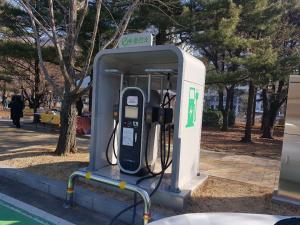Expansion of mandatory installation of electric vehicle chargers and rationalization of control over exclusive charging and parking areas
Occupation of hydrogen charging stations, city parks, and installation of taxi garages within the green belt are permitted

[에너지데일리 조남준 기자] The mandatory installation rate of electric vehicle chargers will be increased from 0.5% for new buildings to 5% from next year, and public buildings such as the state and local governments must install at least 5% of the total parking space as an eco-friendly car parking area.
In addition, hydrogen charging stations are allowed to occupy urban parks and the location of the green belt is expanded, and when a complex hydrogen charging station is built on the site of charging stations such as LPG, the construction area calculation will be reviewed.
The government held the 5th Innovation Growth BIG3 Promotion Meeting (Presiding Deputy Prime Minister of Economic Affairs) at the Export-Import Bank of Korea on the 25th. Announced.
According to this, in relation to electric vehicle charging and parking, electric vehicle chargers will be expanded to focus on living bases such as residences and workplaces.
In the case of new buildings, the mandatory installation ratio of electric vehicle chargers is increased from 0.5% to 5% in 2022, and for existing buildings, installation obligations (2%) are also imposed on private buildings from 2023 starting with public buildings in 2022. .
Accordingly, mandatory installation targets include large marts, department stores, buildings owned by large corporations, and apartments (over 100 households). For the convenience of recharging residents, such as buildings such as coalitions and houses, which are not obligated to install, it is mandatory to open public charging facilities established and operated by the state, local governments, and public institutions, and promote information disclosure such as location and opening hours.
Electric vehicle charging facilities installed as subsidiary facilities of off-street parking have been abolished the area cap, which is to be installed within 20% of the total facility area.
Parking areas for eco-friendly vehicles will also be expanded.
Public buildings such as the state and local governments should install 5% or more of the total number of parking spaces as eco-friendly parking areas for eco-friendly vehicles from 2022, and all off-street parking lots should have 5% or more of the total number of parking spaces for eco-friendly vehicles.
Strengthen the crackdown on prohibiting parking and obstructing charging in electric vehicle-only areas.
The enforcement of electric vehicle charging/parking zones is lowered from the metropolitan government to the basic local government to ensure the effectiveness of the crackdown, and the target of the crackdown is charging facilities that can be regulated when parking a vehicle other than electric vehicles. To enlarge.
In particular, even for slow charging facilities, parking is allowed for up to 12 hours after charging starts, eliminating the inconvenience caused by long-term occupancy.
With regard to charging and using hydrogen vehicles, the speed of construction will be accelerated by improving the location of hydrogen charging stations.
Occupation of hydrogen charging stations in urban parks and installation of taxis and trucks in the green belt are permitted, and when building complex hydrogen charging stations at charging stations such as existing LPG, the construction area calculation and reduction of construction law is reviewed.
This is due to the fact that it is impossible to build beyond the limit of building-to-land ratio (building area/site area) when adding a hydrogen charging station to an existing LPG/CNG charging station. Partial easing of the calculation of the building area was reviewed, and the charging facility in the apartment house is currently applying easing.
In addition, the facility standards are relaxed so that electric vehicle maintenance centers do not have to equip necessary equipment for internal combustion engine maintenance, and hydrogen car drivers are excluded from safety training to improve the convenience of driving hydrogen vehicles, such as proxy driving.
The Ministry of Trade, Industry and Energy Park Jae-young, the manufacturing industry policy officer, said, “To spread the eco-friendly car boom this year, it is essential to improve the convenience of eco-friendly car users in line with people’s life and driving patterns.” We expect that parking facilities will be greatly expanded.”
In addition, Policy Officer Park added, “The Ministry of Trade, Industry and Energy and related ministries will actively respond so that the proposed revised eco-vehicle law can be passed by the National Assembly within this year, and we will prepare for the enforcement of subordinate laws such as the enforcement decree without any problems.”
Copyright © Energy Daily Unauthorized reproduction and redistribution prohibited
